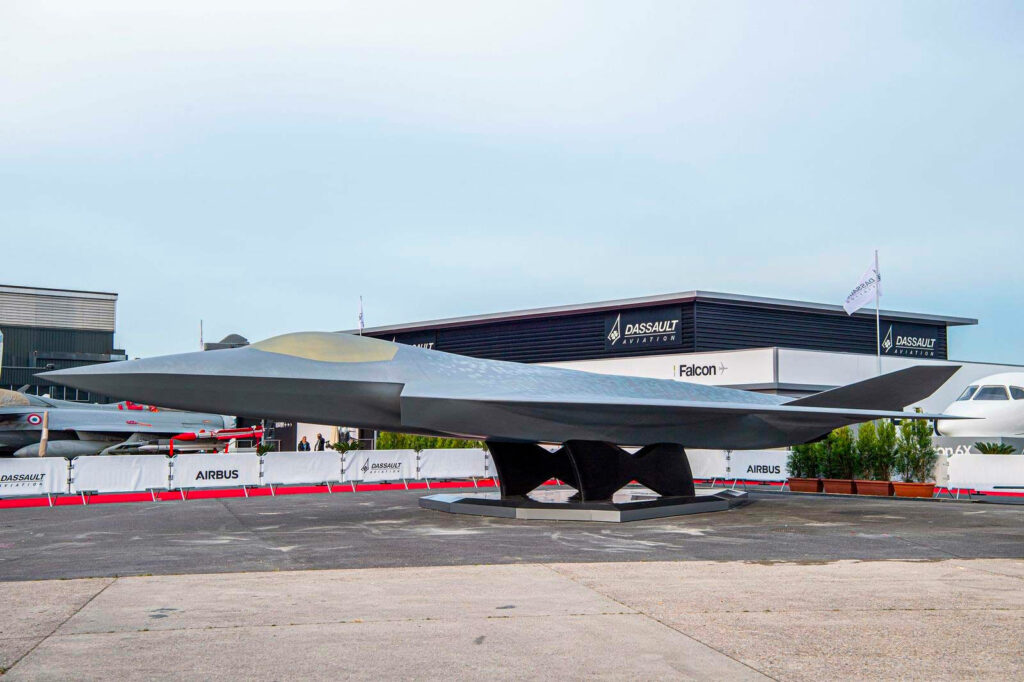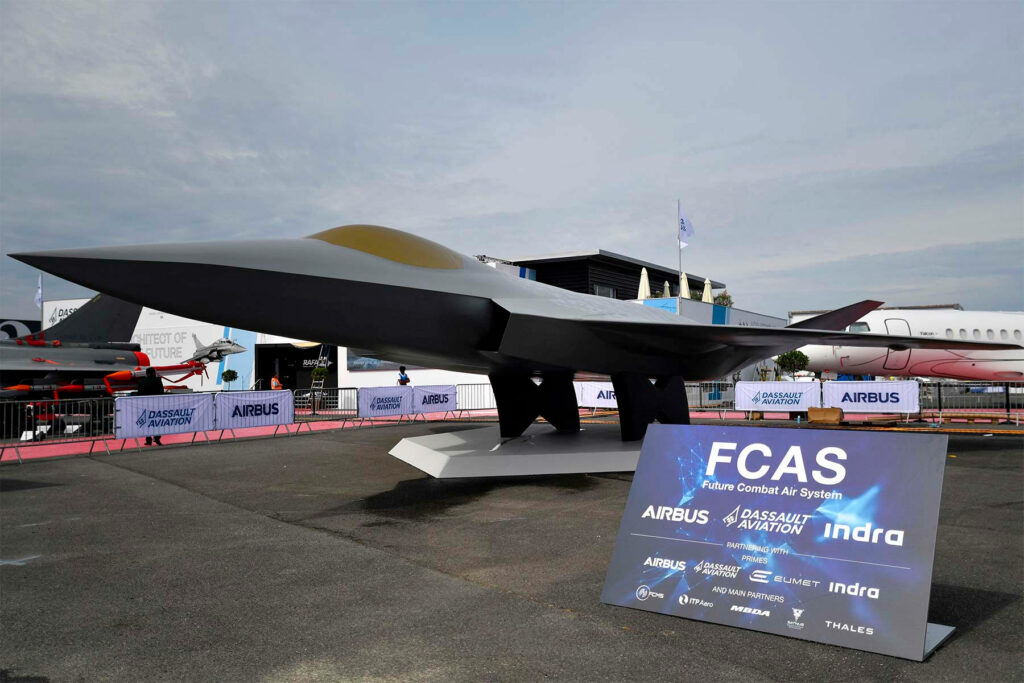The Dassault FCAS is a European 6th-generation fighter concept integrating manned aircraft with unmanned systems and advanced combat cloud capabilities.
The Dassault Future Combat Air System (FCAS) represents a collaborative European initiative to develop a sixth-generation combat aircraft. Designed to replace existing fleets like the Rafale and Eurofighter Typhoon, the FCAS integrates a manned New Generation Fighter (NGF) with unmanned Remote Carriers (RCs) and a sophisticated Air Combat Cloud (ACC) for seamless data fusion and mission coordination. The NGF features advanced stealth technology, supercruise capabilities, and is powered by twin engines producing between 20,000 to 30,000 pounds of thrust each. With a projected maximum speed of approximately 1,243 mph (2,000 km/h) and an operational range of around 2,175 miles (3,500 km), the FCAS is poised to enhance Europe’s aerial combat capabilities by 2040.
History of the Development of the Dassault FCAS
In the early 21st century, European nations recognized the need to modernize their air combat capabilities to address evolving global security challenges. Existing fourth-generation fighters, such as France’s Rafale and the Eurofighter Typhoon operated by Germany and Spain, were becoming increasingly inadequate against advanced air defense systems and fifth-generation adversary aircraft. To maintain a strategic edge, a collaborative approach was deemed essential.
The FCAS initiative was officially launched on July 13, 2017, during the Franco-German Ministerial Council in Paris. France and Germany agreed to jointly develop a next-generation weapon system, marking a significant milestone in European defense cooperation. This partnership aimed to pool resources, expertise, and technological advancements to create a versatile and future-proof air combat system.
Spain joined the program in 2019, further strengthening the consortium and bringing additional industrial capabilities to the project. The inclusion of Spain underscored the program’s importance as a pan-European endeavor to bolster collective defense.
The primary objective of the FCAS program is to develop a New Generation Fighter (NGF) that will operate in conjunction with unmanned systems, known as Remote Carriers (RCs), all integrated through a sophisticated Air Combat Cloud (ACC). This system-of-systems approach is designed to enhance interoperability, situational awareness, and mission effectiveness in complex and contested environments.
The development timeline has been ambitious, with initial plans aiming for a demonstrator flight by 2027 and full operational capability by 2040. However, challenges in coordination among the partner nations and industries have led to adjustments in the schedule. As of 2025, efforts continue to align the program’s milestones with technological readiness and strategic requirements.
The FCAS does not have a specific NATO reporting name, as it remains in the developmental phase. Its designation and nomenclature may evolve as the program progresses toward operational status.

Design of the Dassault FCAS
The design of the Dassault FCAS centers on the New Generation Fighter (NGF), a manned aircraft that embodies the latest advancements in aeronautics and defense technology. The NGF features a sleek, delta-wing configuration with canard foreplanes, optimizing aerodynamic performance and maneuverability. The airframe incorporates advanced stealth characteristics, utilizing composite materials and radar-absorbent coatings to minimize radar cross-section and enhance survivability in contested airspaces.
Measuring approximately 52.5 feet (16 meters) in length, with a wingspan of 34.4 feet (10.5 meters) and a height of 17.6 feet (5.35 meters), the NGF is designed for a single pilot. The cockpit integrates cutting-edge human-machine interface technologies, including augmented reality displays and voice-command systems, to reduce pilot workload and enhance situational awareness.
A notable aspect of the FCAS design is its emphasis on modularity and adaptability. The aircraft is engineered to accommodate various mission-specific payloads and systems, allowing for rapid reconfiguration based on operational requirements. This flexibility is achieved through standardized interfaces and open architecture systems, facilitating seamless integration of new technologies as they emerge.
The NGF is powered by two advanced afterburning turbofan engines, each generating between 20,000 to 30,000 pounds of thrust. These engines are designed to support supercruise capabilities, enabling sustained supersonic flight without the use of afterburners, thereby improving fuel efficiency and reducing thermal signatures. The propulsion system also incorporates thrust vectoring nozzles, enhancing maneuverability and agility during air combat engagements.
One of the innovative features of the FCAS is its integration with unmanned systems. The NGF is designed to operate in concert with Remote Carriers (RCs), which are unmanned aerial vehicles capable of performing a variety of roles, including intelligence, surveillance, reconnaissance, electronic warfare, and strike missions. This manned-unmanned teaming expands the operational envelope of the NGF, allowing it to project power while minimizing risk to human pilots.
The Air Combat Cloud (ACC) serves as the central nervous system of the FCAS, enabling real-time data sharing and collaborative mission planning among all assets within the system. Utilizing advanced artificial intelligence and secure communication networks, the ACC enhances decision-making processes and optimizes resource allocation during complex operations.
While the FCAS design offers numerous advantages, such as enhanced survivability, flexibility, and interoperability, it also presents challenges. The integration of cutting-edge technologies requires significant investment in research and development, as well as close coordination among the partner nations and industries. Additionally, ensuring cybersecurity within the ACC is paramount to prevent potential vulnerabilities in networked warfare. The reliance on data fusion and artificial intelligence also introduces challenges related to system reliability and redundancy in contested environments. Despite these complexities, the FCAS represents a transformative step in European air combat capabilities.
Performance of the Dassault FCAS
The Dassault FCAS is powered by two advanced turbofan engines with thrust vectoring capabilities. These engines are expected to generate between 20,000 and 30,000 pounds of thrust (89 kN to 133 kN) per engine, ensuring high-speed performance and agility. Designed to support supercruise, the aircraft will be able to sustain supersonic speeds without afterburners, improving fuel efficiency and reducing infrared signature.
Speed and Range
The aircraft’s expected maximum speed is approximately 1,243 mph (2,000 km/h, Mach 1.8), making it competitive with other sixth-generation fighters under development. The combat radius is estimated at 650 miles (1,050 km), and its ferry range exceeds 2,175 miles (3,500 km) with external fuel tanks.
Altitude and Maneuverability
The NGF is projected to operate at altitudes of up to 65,000 feet (19,800 meters), allowing it to engage aerial threats and evade ground-based air defenses effectively. The inclusion of thrust vectoring nozzles enhances agility, providing superior maneuverability in dogfight scenarios. The fly-by-wire system is integrated with AI-driven decision aids, reducing pilot workload and optimizing combat performance.
Stealth Capabilities
The NGF incorporates low-observable (LO) technology, utilizing radar-absorbent materials (RAM) and an advanced airframe design that minimizes its radar cross-section (RCS). The internal weapons bays further contribute to stealth characteristics, reducing its detectability compared to fourth and early fifth-generation fighters.
Sensor Suite and Avionics
The FCAS is equipped with a fully networked combat system, integrating active electronically scanned array (AESA) radars, electro-optical targeting sensors, and infrared search and track (IRST) systems. These provide superior beyond-visual-range engagement capabilities and enhanced situational awareness.
Compared to its main competitors, such as the US NGAD (Next Generation Air Dominance) program and the UK-led Tempest, the FCAS focuses more on integrated systems-of-systems warfare rather than purely aircraft performance. While its exact thrust-to-weight ratio and acceleration figures remain classified, the supercruise capability and high-altitude performance position it as a formidable opponent in aerial engagements.
Variants of the Dassault FCAS
The FCAS program includes multiple variants and components, designed to function within an interconnected system:
- New Generation Fighter (NGF): The manned aircraft serving as the centerpiece of the FCAS program, designed for air superiority and multi-role operations.
- Remote Carriers (RCs): Unmanned aerial vehicles (UAVs) designed to support the NGF. These come in two sizes:
- RC-100: Larger drones capable of carrying weapons, jammers, and sensors.
- RC-200: Smaller, expendable drones for electronic warfare and decoys.
- Air Combat Cloud (ACC): The digital backbone of the FCAS, integrating all assets through a secure and AI-driven network.
Each component plays a crucial role in ensuring the interoperability, flexibility, and survivability of the FCAS in high-intensity conflicts.

Military Missions of the Dassault FCAS
The Dassault FCAS is designed for multi-domain air superiority, integrating offensive and defensive capabilities across various mission profiles.
Air-to-Air Combat
The NGF is armed with beyond-visual-range air-to-air missiles (BVRAAMs), such as the MBDA Meteor, offering engagement ranges exceeding 100 miles (160 km). For close-range engagements, it carries infrared-guided missiles like the MICA NG.
Air-to-Ground and Strike Capabilities
For precision strikes, the NGF is equipped with SCALP-EG cruise missiles, Hammer precision-guided bombs, and anti-ship missiles. These allow the FCAS to conduct deep-penetration strikes while maintaining low observability.
Electronic Warfare and ISR
Equipped with advanced electronic countermeasures (ECM), cyber warfare tools, and SIGINT/ELINT sensors, the FCAS is designed to disrupt enemy radar and communications. The Remote Carriers further enhance its electronic warfare and intelligence-gathering roles.
Unmanned Teaming and Network-Centric Warfare
One of the FCAS’s defining features is its ability to operate seamlessly with unmanned assets. The NGF serves as a command node, directing swarm attacks with RC drones while maintaining network superiority through the Air Combat Cloud.
Competing Aircraft and Market Prospects
The FCAS faces competition from the US NGAD, UK Tempest, and China’s J-XX programs. While it is primarily intended for European nations, potential export customers include India and the UAE. However, political and economic considerations may affect international sales.
Deployment Timeline
The FCAS is expected to replace the Rafale, Eurofighter Typhoon, and F/A-18 Hornet in European air forces starting in 2040. Its deployment will coincide with the phasing out of fourth and fifth-generation fighters, ensuring continued European air dominance.
With planned operational capability by 2040, the FCAS represents Europe’s commitment to next-generation air superiority. While delays and cost challenges remain, the program is central to European defense strategy, ensuring a high-tech, independent aerial combat capability.
Back to the Fighter Jet section.